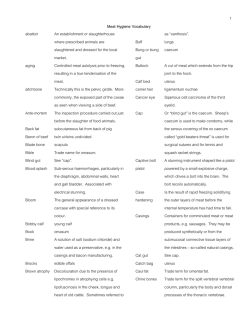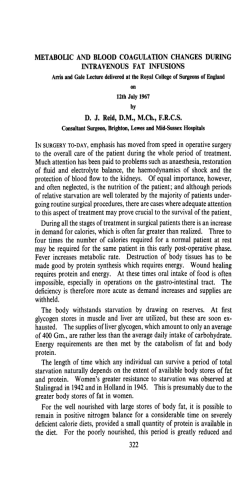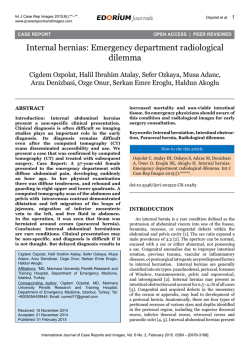
Study and classification of the abdominal adiposit
Nutr Hosp. 2010;25(2):270-274 ISSN 0212-1611 • CODEN NUHOEQ S.V.R. 318 Original Study and classification of the abdominal adiposity throughout the application of the two-dimensional predictive equation Garaulet et al., in the clinical practice C. M.ª Piernas Sánchez, E. M.ª Morales Falo, S. Zamora Navarro and M. Garaulet Aza Department of Physiology. University of Murcia. Campus de Espinardo. Murcia. Spain. Abstract Introduction: The excess of visceral abdominal adipose tissue is one of the major concerns in obesity and its clinical treatment. Objective: To apply the two-dimensional predictive equation proposed by Garaulet et al. to determine the abdominal fat distribution and to compare the results with the body composition obtained by multi-frequency bioelectrical impedance analysis (M-BIA). Subjects/methods: We studied 230 women, who underwent anthropometry and M-BIA. The predictive equation was applied. Multivariate lineal and partial correlation analyses were performed with control for BMI and % body fat, using SPSS 15.0 with statistical significance P < 0.05. Results: Overall, women were considered as having subcutaneous distribution of abdominal fat. Truncal fat, regional fat and muscular mass were negatively associated with VA/SApredicted, while the visceral index obtained by M-BIA was positively correlated with VA/SApredicted. Discussion/Conclusion: The predictive equation may be useful in the clinical practice to obtain an accurate, costless and safe classification of abdominal obesity. (Nutr Hosp. 2010;25:270-274) DOI:10.3305/nh.2010.25.2.4544 Key words: Abdominal obesity. Visceral adipose tissue. Multi-frequency bioelectrical impedance analysis. Anthropometry. Truncal fat. ESTUDIO Y CLASIFICACIÓN DE LA ADIPOSIDAD ABDOMINAL MEDIANTE LA APLICACIÓN DE LA ECUACIÓN PREDICTIVA BIDIMENSIONAL DE GARAULET ET AL., EN LA PRÁCTICA CLÍNICA Resumen Introducción: El exceso de tejido adiposo abdominal visceral es una de las mayores preocupaciones en la obesidad y su tratamiento clínico. Objetivo: Aplicar la ecuación predictiva bidimensional propuesta por Garaulet et al., para determinar la distribución de la grasa abdominal y comparar los resultados con la composición corporal obtenida mediante el análisis de impedancia bioeléctrica multi-frecuencia (M-BIA). Sujetos/métodos: Estudiamos a 230 mujeres a las que se sometió a antropometría y M-BIA. Se aplicó la ecuación predicitiva. Se realizaron correlaciones lineales multivariadas y parciales controlando el IMC y el % de grasa corporal, utilizando SPSS 15.0 con significación estadística P < 0,05. Resultados: En global, se consideró que las mujeres tenían una distribución subcutánea de la grasa abdominal. La grasa troncal, regional y la masa muscular se asociaron negativamente con VA/SApredicha, mientras que le índice visceral obtenido mediante M-BIA se correlacionó positivamente con VA/SApredicha. Discusión/conclusión: La ecuación predictiva puede ser útil en la práctica clínica para obtener una clasificación segura, barata y precisa de la obesidad abdominal. (Nutr Hosp. 2010;25:270-274) DOI:10.3305/nh.2010.25.2.4544 Palabras clave: Obesidad abdominal. Tejido adiposo visceral. Análisis por impedancia bioeléctrica de multifrecuencia. Antropometría. Grasa troncal. Correspondence: Marta Garaulet Aza. Department of Physiology. University of Murcia. Campus de Espinardo, s/n 30100 Murcia. Spain. E-mail: [email protected] Recibido: 13-X-2009. Aceptado: 26-X-2009. 270 Introduction One the major concerns in the clinical treatment of obesity is the excess of adipose tissue located in the abdominal region and it´s increased associated risk. The visceral adipose tissue (VAT) is considered the clinically relevant type of body fat independently of total body fat,1 closely linked with increased risk of type 2 diabetes and cardiovascular disease.2 Imaging techniques as magnetic resonance imaging (RMI) or computed tomography (CT)3 ensure an accurate quantification of abdominal fat compartments, but their economic cost and complexity make them not suitable in the clinical practice or in large-scale studies. Although several anthropometric measures have been validated as indicators of VAT or SAT compartments,4 no single parameters are considered as accurate measures of both fat deposits.5 Also, it has been suggested that one-dimensional variables are not complete models for estimating two-dimensional parameters such as cross-sectional fat areas,6 that have been described as ellipses rather than circles, even in obese subjects.7 Based on this fact, Garaulet et al. have developed a two-dimensional equation,8 based on the elliptical model, using the classical ratio of visceral area (VA) over subcutaneous area (SA) at the umbilicus level. This equation was validated in obese subjects who underwent computed tomography and anthropometry and was established a cut-off point at the level of 0.42. The classical VA/SA ratio has been used as a diagnostic criterion for classifying obesity into subcutaneous and visceral types9 and has shown important associations with metabolic disturbances.10 Bioelectrical Impedance analysis (BIA) is a popular alternative to assess body composition because is a safe, non-invasive and portable method. Modern multifrequency BIA (M-BIA) technology also includes the ability to provide total body fatness and regional estimates such as truncal fatness.11 Recent studies have shown good agreement between M-BIA and dualenergy X-ray absorptiometry (DXA) for estimating changes in body composition during weight loss in overweight young women.12 However, M-BIA may not be widely available in the clinical practice. The purpose of the present study was to apply a twodimensional predictive equation proposed by Garaulet et al.8 to determine the abdominal fat distribution in women included in a cognitive-behavioral therapy for the treatment of obesity,13 and to compare the results with the body composition obtained by M-BIA, with the purpose to reach a more accurate, costless and easier classification of the abdominal obesity in the clinical practice mainly based in the application of the predictive equation. Subjects and methods body fat 35.4 ± 5.3, who visited the “Garaulet Nutritional Centers”, in Murcia, Spain, and were included in a cognitive-behavioral therapy based on the Mediterranean diet for the treatment of obesity.13 The Ethics Committee of the University of Murcia approved this study and the informed consent was obtained before the experiments. Anthropometric measurements According to SEEDO 2007 Consensus,14 body weight was measured by a clinical scale with 100 g recess, and body height was measured with a Harpender digital stadiometer (0.7-2.05 m range), in barefooted subjects. BMI was calculated as weight (kilograms) divided by squared height (meters). Body fat distribution was assessed using the waist circumference (WC) at the level of the umbilicus; hip circumference (HC) over the widest part of the greater trocanters; sagittal diameter was measured at the level of the iliac crest (L4-5) using a Holtain Kahn Abdominal Caliper,15 as the distance between the examination table up to the horizontal level, allowing the caliper arm to touch the abdomen slightly but without compression;16 and coronal diameter was measured at the level of iliac crest (L4-5), with the patient lying in a supine position in the examination table. The abdominal caliper was perpendicular to the body.15 The waist to hip ratio (WHR) was also calculated.17 Skinfold thicknesses (biceps, triceps, subscapular and suprailiac) were measured with a Harpender calliper (Holtain Ltd., Bryberian, Crymmych, Pembrokeshire), on the right side of the body with the subject standing up in a relaxed position. The complete set of anthropometric measurements was performed three times but not consecutively, and were obtained in order and repeated a second and a third time. All these measurements were carried out by the same person. To analyze the abdominal fat distribution, the two-dimensional predictive equation proposed by Garaulet et al.,8 was calculated with the following formula: Visceral area (VA)/Subcutaneous area (SA) predicted = 0.868 + (0.064 x sagittal diameter) – (0.036 x coronal diameter) – (0.022 x triceps skinfold). According to the values obtained by the predictive equation in the present study, we classified individuals into subcutaneous and visceral group using the cut-off point proposed by Garaulet et al. who have classified visceral obese subjects as those individuals with VA/SApredicted * 0.42. Subjects Multi-frequency bioelectric impedance analysis (M-BIA) The studied population was composed by 230 women, aged 39 ± 12 years, with BMI 29 ± 5 and % To guarantee the maximum accuracy of the data, all the measurements were performed in bare-footed and Study and classification of the abdominal adiposity Nutr Hosp. 2010;25(2):270-274 271 fasting individuals. These measures were obtained by TANITA MC-180 (TANITA Corporation of America, Inc, Arlington Heights, IL, USA), equipped with 8 tactile electrodes: a platform with 2 electrodes for each foot and two handgrips with two electrodes each. We obtained total body measures, excluding the head, such as total body fat (% and kg), muscular mass (kg), fat free mass (kg), total body water (kg); and the regional measures were truncal fat (kg), visceral index, muscular truncal mass (kg), fat leg mass (kg), fat arm mass (kg), muscular leg mass (kg) and muscular arm mass (kg). The visceral index obtained by M-BIA has been previously validated through Computed Tomography and DXA in both spinal-cord injured and healthy patients respectively. Statistical analysis Data are expressed as mean ± s.e.d. Statistical differences between means were tested using multivariate lineal analyses controlled for BMI and total body fat (%). Partial correlation coefficients controlled for BMI and total body fat (%) were performed to determine the relations between general characteristics, anthropometrical variables and M-BIA data, with VA/SApredicted by the two-dimensional equation. All statistical procedures were performed using SPSS 15.0 for Windows (SPSS Inc., Chicago, USA). Statistical significance was defined with P values < 0.05. Results General characteristics, anthropometry and multi-frequency bioelectric impedance data Clinical and M-BIA data from the total population are presented in Table 1. The studied population presented overweight (BMI = 29 ± 5). The mean value of VA/SApredicted classified females with subcutaneous distribution. Women had mean values of total body fat (%) considered as obesity.14 Classification of individuals according to the VA/SApredicted To classify the total population into subcutaneous or visceral abdominal distribution we used the cut-off point proposed by Garaulet et al. (table I). The subcutaneous group presented significantly higher values of weight, coronal diameter, skinfold thicknesses, fat free mass, total body water, truncal fat (% respect to total fat), muscular truncal and leg mass. The visceral group presented significant higher values of sagittal diameter. The visceral index obtained by M-BIA was not significantly different between groups, but it was slightly higher in the visceral group. 272 Nutr Hosp. 2010;25(2):270-274 Associations between VA/SApredicted and the variables derived from anthropometry and M-BIA analysis Table II shows the partial correlation coefficients between anthropometric and M-BIA measures and VA/SApredicted values. Regarding the anthropometric variables, hip circumferences (HC) (P < 0.05), coronal diameter (P < 0.001) and skinfold thicknesses (P < 0.001) were significantly and negatively correlated with the predictive equation values. Whereas, sagittal diameter correlated positively. We also observed significant and negative correlations between the equation values and fat free mass, total body water, truncal fat (P < 0.01) and muscular truncal (P < 0.05) and leg mass (P < 0.01). The predictive equation was significantly and positively associated with the visceral index obtained by M-BIA (P < 0.001). Discussion The present study was designed to show the effectiveness of the two-dimensional predictive equation in the classification of the abdominal obesity in the clinical practice. It has been stated that no single clinical anthropometric measure correlates well with visceral adipose tissue (VAT) in the prediction of the abdominal fat depot.11 The equation published by Garaulet et al., is composed by coronal and sagittal diameters plus triceps skinfold, having the advantage that can measure two-dimensional variables as cross-sectional areas like VAT.6 Those three variables were revealed as strong and significant contributors to the explained variance of VA/SA obtained by computed tomography (CT) by multiple regression analysis.8 This equation showed more accuracy than previous models such as the circular model, the elliptical model using different abdominal and back skinfolds,7 and even more than the classical visceral obesity classification proposed by Tarui et al.9 In the studied population, women presented overweight and had waist circumference and waist-to-hip ratio (WHR) slightly greater than the accepted highly risk cut-off points.14 Taking into account these variables, women presented little risk of metabolic disturbances associated with obesity.18 The application of the predictive equation revealed that, overall, women were considered as having a subcutaneous distribution of the abdominal fat. After statistical control for BMI and total body fat (%), a positive correlation between the VA/SApredicted and the visceral index (VI) obtained by M-BIA was found. Considering the VI as an indicator of visceral obesity, we can assume that the equation is classifying the patients adequately. Measures of visceral adiposity through M-BIA have shown important correlations with visceral area determined by CT and DXAThe VI has been validated throughout CT in both healthy individuals and patients with spinal cord injury,19 and even stronger correlations than the waist circumference.19,20 C. M.ª Piernas Sánchez et al. Table I General characteristics, anthropometric and multi-frequency bioelectric impedance data in the total population and differences between means classifying women according to VA/SApredicted Weight (kg) Waist (cm) Hip (cm) WHR Coronal diameter (cm) Sagittal diameter (cm) Biceps skinfold (mm) Triceps skinfold (mm) Subscapular skinfold (mm) Suprailiac skinfold (mm) VA/SApredicted Visceral Index Total Body Fat (kg) Muscular mass (kg) Fat free mass (kg) Total body water (kg) Truncal fat (kg) Truncal fat (% respect to total fat) Fat leg mass (kg) Fat arm mass (kg) Muscular truncal mass (kg) Muscular leg mass (kg) Muscular arm mass (kg) Total population n = 230 Subcutaneous group VA/SApredicted ≤ 0.42 (n = 164) Visceral group VA/SApredicted > 0.42 (n = 66) p 75 ± 13 91.54 ± 11.08 106.89 ± 10.06 0.86 ± 0.08 33.74 ± 4.40 20.92 ± 3.01 15.75 ± 7.48 30.30 ± 8.01 29.15 ± 9.87 31.47 ± 9.56 0.33 ± 0.19 6,29 ± 2,87 26.73 ± 8.45 45.17 ± 6.79 47.40 ± 6.20 33.91 ± 4.47 12.60 ± 4.31 46.39 ± 7.54 5.52 ± 1.60 1.52 ± 0.68 26.13 ± 3.56 7.31 ± 0.97 2.17 ± 0.32 75.56 ± 0.45 91.66 ± 0.46 107.33 ± 0.54 0.86 ± 0.01 34.52 ± 0.22 20.71 ± 0.12 16.49 ± 0.44 32.59 ± 0.40 30.01 ± 0.59 32.42 ± 0.62 0.23 ± 0.01 6.20 ± 0.12 26.79 ± 0.20 45.47 ± 0.37 47.69 ± 0.31 34.11 ± 0.22 12.80 ± 0.13 47.50 ± 0.29 5.49 ± 0.04 1.52 ± 0.02 26.27 ± 0.17 7.38 ± 0.06 2.19 ± 0.02 73.39 ± 0.72 90.62 ± 0.75 105.45 ± 0.87 0.86 ± 0.01 31.63 ± 0.36 21.21 ± 0.20 13.05 ± 0.71 23.75 ± 0.65 26.31 ± 0.95 28.98 ± 1.01 0.56 ± 0.02 6.59 ± 0.20 26.43 ± 0.33 44.08 ± 0.61 46.25 ± 0.49 33.08 ± 0.36 12.32 ± 0.21 46.38 ± 0.46 5.54 ± 0.06 1.51 ± 0.03 25.46 ± 0.28 7.12 ± 0.09 2.13 ± 0.03 0.013 0.248 0.073 0.699 0.000 0.039 0.000 0.000 0.001 0.005 0.000 0.110 0.367 0.058 0.016 0.017 0.057 0.046 0.553 0.816 0.016 0.020 0.105 Data are presented as mean ± s.e.d. BMI: body mass index, WHR: waist to hip ratio. VA: visceral area, SA: subcutaneous area. Bold characters indicate significant differences between groups with P ) 0.05. Multivariate lineal analysis was controlled for BMI (body mass index) and total body fat (%). The partial correlation analysis also revealed negative correlations between VA/SApredicted and truncal fat, regional fat and muscular mass. These results support the fact that women tend to gain more subcutaneous fat in the abdominal region. This observation is consistent with others that states that premenopausal20 premenopausal21 and postmenopausal22 women have more abdominal subcutaneous adipose tissue than men. The utilization of the predictive equation proposed by Garaulet et al. (2006) may have some advantages over M-BIA, especially if modern equipments of MBIA are not available in the daily practice. However, some limitations may be taken into account. One of the key issues is how the triceps skinfold, a negative component of the equation, affects the values of VA/SA predicted. Our results showed that the visceral group (VA/SApredicted * 0.42) had significantly less weight and truncal fat (% respect to total fat) than the subcutaneous group. These results could be explained by significantly fewer values of triceps in the women classified as visceral group compared with those clas- Study and classification of the abdominal adiposity sified in the subcutaneous group (Table 2). This skinfold has been shown to be highly correlated to total body fat in different population groups22,23 groups,23,24 and was correlated to subcutaneous fat in the previous study of Garaulet et al.8 In this case, the triceps skinfold is diving women according to the % of body fat. On the other hand, the predictive equation was validated in obese women, while women in the present study presented overweight, although both population had a wide range of BMI and % total body fat. To avoid the influence of obesity degree, the statistical analyses were controlled for both variables. In summary, the predictive equation proposed by Garaulet et al. (2006) has satisfactorily classified overweight women with a subcutaneous distribution of the abdominal fat, and the results showed good agreement with the visceral index and other variables derived from M-BIA. The predictive equation is useful in the clinical practice and can be applied without any other method or equipment to obtain an accurate, costless and safe classification of the obese patients. Nutr Hosp. 2010;25(2):270-274 273 Table II Partical correlation coefficients for the independent association between VA/SA predicted and total body composition Total population Waist (cm) Hip (cm) WHR Coronal diameter (cm) Sagittal diameter (cm) Biceps skinfold (mm) Triceps skinfold (mm) Subscapular skinfold (mm) Suprailiac skinfold (mm) Total Body Fat (kg) Muscular mass (kg) Fat free mass (kg) Total body water (%) Truncal fat (kg) Truncal fat (% respect to total fat) Visceral Index Fat leg mass (kg) Fat arm mass (kg) Muscular truncal mass (kg) Muscular leg mass (kg) Muscular arm mass (kg) NS -0.135* NS -0.515‡ 0.258‡ -0.316‡ -0.723‡ -0.209† -0.159* NS NS -0.181† -0.197† -0.183† -0.151* 0.246‡ NS NS -0.161* -0.171† NS WHR: waist to hip ratio. Partial correlation analysis was controlled for BMI and total body fat (%). *p < 0.05; †p < 0.01; ‡p < 0.001. NS: not significant. Acknowledgements We thank the Garaulet Centers of Nutrition located in Cartagena, Molina de Segura and Murcia, Spain, and its managers for exceptional assistance and help in the data acquisition. None of the authors has conflict of interests of any type with respect to this manuscript. This work was supported by the Government of Education, Science and Research of Murcia (project BIO/FFA 07/01-0004) and by the Spanish Government of Science and Innovation (projects AGL2008-01655/ALI). References 1. DeNino WF, Tchernof A, Dionne IJ, Toth MJ, Ades PA, Sites CK et al. Contribution of abdominal adiposity to age-related differences in insulin sensitivity and plasma lipids in healthy nonobese women. Diabetes Care 2001; 24: 925-32. 2. Kahn BB, Flier JS. Obesity and insulin resistance. J Clin Invest 2000; 106: 473-81. 3. Deurenberg P, Yap M. The assessment of obesity: methods for measuring body fat and global prevalence of obesity. Baillieres Best Pract Res Clin Endocrinol Metab 1999; 13: 1-11. 4. Bonora E, Micciolo R, Ghiatas AA, Lancaster JL, Alyassin A, Muggeo M et al. Is it possible to derive a reliable estimate of human visceral and subcutaneous abdominal adipose tissue from simple anthropometric measurements? Metabolism 1995; 44: 1617-25. 5. Valsamakis G, Chetty R, Anwar A, Banerjee AK, Barnett A, Kumar S. Association of simple anthropometric measures of obesity with visceral fat and the metabolic syndrome in male Caucasian and Indo-Asian subjects. Diabet Med 2004; 21: 1339-45. 274 Nutr Hosp. 2010;25(2):270-274 6. Van der Kooy K, Leenen R, Seidell JC, Deurenberg P, Visser M. Abdominal diameters as indicators of visceral fat: comparison between magnetic resonance imaging and anthropometry. Br J Nutr 1993; 70: 47-58. 7. He Q, Engelson ES, Wang J, Kenya S, Ionescu G, Heymsfield SB et al. Validation of an elliptical anthropometric model to estimate visceral compartment area. Obes Res 2004; 12: 250-7. 8. Garaulet M, Hernández-Morante JJ, Tebar FJ, Zamora S, Canteras M. Two-dimensional predictive equation to classify visceral obesity in clinical practice. Obesity (Silver Spring) 2006; 14: 1181-91. 9. Tarui S, Tokunaga K, Fujioka S, Matsuzawa Y. Visceral fat obesity: anthropological and pathophysiological aspects. Int J Obes 1991; 15 (Suppl. 2): 1-8. 10. Fujioka S, Matsuzawa Y, Tokunaga K, Tarui S. Contribution of intra-abdominal fat accumulation to the impairment of glucose and lipid metabolism in human obesity. Metabolism 1987; 36: 54-9. 11. Joy T, Kennedy BA, Al-Attar S, Rutt BK, Hegele RA. Predicting abdominal adipose tissue among women with familial partial lipodystrophy. Metabolism 2009; 58: 828-34. 12. Thomson R, Brinkworth GD, Buckley JD, Noakes M, Clifton PM. Good agreement between bioelectrical impedance and dual-energy X-ray absorptiometry for estimating changes in body composition during weight loss in overweight young women. Clin Nutr 2007; 26: 771-7. 13. Corbalán MD, Morales EM, Canteras M, Espallardo A, Hernandez T, Garaulet M. Effectiveness of cognitive-behavioral therapy based on the Mediterranean diet for the treatment of obesity. Nutrition 2009; 25: 861-9. 14. Salas-Salvado J, Rubio MA, Barbany M, Moreno B. [SEEDO 2007 Consensus for the evaluation of overweight and obesity and the establishment of therapeutic intervention criteria]. Med Clin (Barc) 2007; 128: 184-96; quiz 181 p following 200. 15. Kahn HS. Choosing an index for abdominal obesity: an opportunity for epidemiologic clarification. J Clin Epidemiol 1993; 46: 491-4. 16. Riserus U, Arnlov J, Brismar K, Zethelius B, Berglund L, Vessby B. Sagittal abdominal diameter is a strong anthropometric marker of insulin resistance and hyperproinsulinemia in obese men. Diabetes Care 2004; 27: 2041-6. 17. Valdez R, Seidell JC, Ahn YI, Weiss KM. A new index of abdominal adiposity as an indicator of risk for cardiovascular disease. A cross-population study. Int J Obes Relat Metab Disord 1993; 17: 77-82. 18. Katzmarzyk PT, Srinivasan SR, Chen W, Malina RM, Bouchard C, Berenson GS. Body mass index, waist circumference, and clustering of cardiovascular disease risk factors in a biracial sample of children and adolescents. Pediatrics 2004; 114: e198-205. 19. Yamaguchi Y, Sakamoto Y, Kasahara Y, Sato H, Ikeda Y. Study on the measurement of visceral fat using abdominal BIA. J Japan Society for the Study of Obesity 2006; 12. 20. Demura S, Sato S.Prediction of visceral fat area at the umbilicus level using fat mass of the trunk: The validity of bioelectrical impedance analysis. J Sports Sci 2007; 25 (7):823-33. 21. Pouliot MC, Despres JP, Lemieux S, Moorjani S, Bouchard C, Tremblay A et al. Waist circumference and abdominal sagittal diameter: best simple anthropometric indexes of abdominal visceral adipose tissue accumulation and related cardiovascular risk in men and women. Am J Cardiol 1994; 73: 460-8. 22. Schreiner PJ, Terry JG, Evans GW, Hinson WH, Crouse JR, 3rd, Heiss G. Sex-specific associations of magnetic resonance imaging-derived intra-abdominal and subcutaneous fat areas with conventional anthropometric indices. The Atherosclerosis Risk in Communities Study. Am J Epidemiol 1996; 144: 33545. 23. García AL, Wagner K, Hothorn T, Koebnick C, Zunft HJ, Trippo U. Improved prediction of body fat by measuring skinfold thickness, circumferences, and bone breadths. Obes Res 2005; 13: 626-34. 24. Kwok T, Woo J, Lau E. Prediction of body fat by anthropometry in older Chinese people. Obes Res 2001; 9: 97-101. C. M.ª Piernas Sánchez et al.
© Copyright 2025



